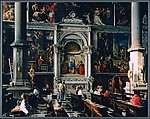San Zaccaria, Venice
Thomas Struth German
Not on view
In the center of Struth's photograph is Giovanni Bellini's luminous San Zaccaria altarpiece (1505), which reigns over the adjacent paintings and all the surrounding space. The Madonna and Child and the saints share an attitude of deeply spiritual communion and radiate a field of calm beyond the airy apse in which they are ensconced. Through his mastery of light and perspective, Bellini created the illusion that the space exists just beyond the wall, while Struth used photography's trompe l'oeil effect to bring the marble niche forward, as if to float on the very surface of the photograph. Two tourist-pilgrims enraptured by the painting demonstrate its scale; others seated in the pews, also quiet and meditative, mark off the receding perspective. Everything in the photograph seems to exist in the same sensuous, orderly world—as if Bellini's and Struth's monumental images of sacred spaces washed in translucent Venetian light actually were of the same moment.
Struth's picture unifies the timeless and the ephemeral, making the ideal and the real two perspectives on the same theme. But if his photograph rivals painting on the high ground of seriousness and looks back upon five hundred years of tradition, it also faces forward: It will convey this inheritance to the next new medium that will, in turn, reflect upon photography and painting.
Due to rights restrictions, this image cannot be enlarged, viewed at full screen, or downloaded.

